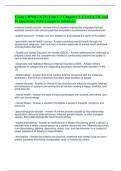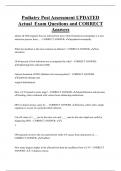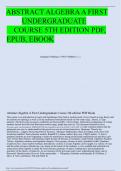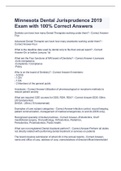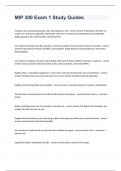Exam 1 RNSG 1125 (Unit 1-2 Chapters 1,2,3,4,5,6,7,8, and
9) Questions With Complete Solutions
evidence-based practice - Answer-clinical decision making that integrates the best
available research with clinical expertise and patient characteristics and preferences
/.patient advocate - Answer-one who speaks for and protects the rights of the patient
/.psychiatric mental health nursing - Answer-promoting mental health through the
assessment, diagnosis, and treatment of human responses to mental health problems
and psychiatric disorders
/.Quality and Safety Education for Nurses (QSEN) - Answer-addresses the challenge to
prepare nurses with the competencies needed to continuously improve the quality of
care in their work environments
/.Diagnostic and Statistical Manual of Mental Disorders (DSM) - Answer-Official
guidebook for categorizing ans diagnosing psychiatric mental health disorders in the
US.
/.Epidemiology - Answer-Branch of medical science concerned with the incidence,
distribution, and control of diseases that affect large numbers of people.
/.mental disorder - Answer-an illness of the mind that can affect the thoughts, feelings,
and behaviors of a person, preventing him or her from leading a happy, healthful, and
productive life
/.mental health - Answer-the state of being comfortable with yourself, with others, and
with your surroundings
/.mental illness - Answer-a disorder that affects a person's thoughts, emotions, and
behaviors
/.psychobiological disorder - Answer-A mental disorder caused by neurotransmitter
dysfunction, abnormal brain srtructure, inherited genetic factors, or other biological
causes. Also called biologically based mental illness
/.stigma/stigmatizing - Answer-an attribute that is deeply discrediting where a person is
reduced from a whole unusual person to a tainted, discounted one. Stigmatizing comes
from stereotyping, labeling, separating, status, loss, and discrimination in a context of
power imbalance all leading to stigmatization
/.boundaries - Answer-Boundaries are physical, emotional and mental limits we set to
protect ourselves from being manipulated, used, or harmed by others.
,/.ego - Answer-the largely conscious, "executive" part of personality. Operates on the
reality principle, satisfying the id's desires in ways that will realistically bring pleasure
rather than pain.
/.id - Answer-a reservoir of unconscious psychic energy that, according to Freud, strives
to satisfy basic sexual and aggressive drives. Operates on the pleasure principle,
demanding immediate gratification.
/.self-actualization - Answer-according to Maslow, one of the ultimate psychological
needs that arises after basic physical and psychological needs are met and self-esteem
is achieved; the motivation to fulfill one's potential
/.HEADSSS psychosocial interview technique - Answer-H Home environment (e.g.,
relations with parents and siblings)
E Education and employment (e.g., school performance)
A Activities (e.g., sports participation, after-school activities, peer relations)
D Drug, alcohol, or tobacco use
S Sexuality (e.g., whether the patient is sexually active, practices safe sex, or uses
contraception)
S Suicide risk or symptoms of depression or other mental disorder
S "Savagery" (e.g., violence or abuse in home environment or in neighborhood)
/.Psychiatric Nursing Assessment - Answer-The psychiatric mental health nurse collects
and synthesizes comprehensive health data that are pertinent to the health care
consumer's health and/or situation.
Nurses who work in the mental health field need to assess, or have access to, past and
present medical history, a recent physical examination, and any physical complaints the
patient is experiencing, as well as document any observable physical conditions or
behaviors (unsteady gait, abnormal breathing pattern, facial grimacing, or changing
position to relieve discomfort).
/.mental status exam - Answer-a set of interview questions and observations designed
to reveal the degree and nature of a client's abnormal functioning
/.A new staff nurse completes an orientation to the psychiatric unit. This nurse will
expect to ask an advanced practice nurse to perform which action for patients?
a. Perform mental health assessment interviews.
b. Prescribe psychotropic medication.
c. Establish therapeutic relationships.
d. Individualize nursing care plans. - Answer-ANS: B
Prescriptive privileges are granted to master's-prepared nurse practitioners who have
taken special courses on prescribing medication. The nurse prepared at the basic level
,performs mental health assessments, establishes relationships, and provides
individualized care planning. Note that this question was also offered for Chapter 1.
/.A newly admitted patient diagnosed with major depression has gained 20 pounds over
a few months and has suicidal ideation. The patient has taken an antidepressant
medication for 1 week without remission of symptoms. Select the priority nursing
diagnosis.
a. Imbalanced nutrition: more than body requirements
b. Chronic low self-esteem
c. Risk for suicide
d. Hopelessness - Answer-ANS: C
Risk for suicide is the priority diagnosis when the patient has both suicidal ideation and
a plan to carry out the suicidal intent. Imbalanced nutrition, hopelessness, and chronic
low self-esteem may be applicable nursing diagnoses, but these problems do not affect
patient safety as urgently as would a suicide attempt.
/.A patient diagnosed with major depression has lost 20 pounds in one month, has
chronic low self-esteem, and a plan for suicide. The patient has taken an antidepressant
medication for 1 week. Which nursing intervention has the highest priority?
a. Implement suicide precautions.
b. Offer high-calorie snacks and fluids frequently.
c. Assist the patient to identify three personal strengths.
d. Observe patient for therapeutic effects of antidepressant medication. - Answer-ANS:
A
Implementing suicide precautions is the only option related to patient safety. The other
options, related to nutrition, self-esteem, and medication therapy, are important but are
not priorities.
/.The desired outcome for a patient experiencing insomnia is, "Patient will sleep for a
minimum of 5 hours nightly within 7 days." At the end of 7 days, review of sleep data
shows the patient sleeps an average of 4 hours nightly and takes a 2-hour afternoon
nap. The nurse will document the outcome as:
a. consistently demonstrated.
b. often demonstrated.
c. sometimes demonstrated.
d. never demonstrated. - Answer-ANS: D
Although the patient is sleeping 6 hours daily, the total is not one uninterrupted session
at night. Therefore, the outcome must be evaluated as never demonstrated. See
relationship to audience response question.
, /.The desired outcome for a patient experiencing insomnia is, "Patient will sleep for a
minimum of 5 hours nightly within 7 days." At the end of 7 days, review of sleep data
shows the patient sleeps an average of 4 hours nightly and takes a 2-hour afternoon
nap. What is the nurse's next action?
a. Continue the current plan without changes.
b. Remove this nursing diagnosis from the plan of care.
c. Write a new nursing diagnosis that better reflects the problem.
d. Examine interventions for possible revision of the target date. - Answer-ANS: D
Sleeping a total of 5 hours at night remains a reasonable outcome. Extending the period
for attaining the outcome may be appropriate. Examining interventions might result in
planning an activity during the afternoon rather than permitting a nap. Continuing the
current plan without changes is inappropriate. Removing this nursing diagnosis from the
plan of care would be correct when the outcome was met and the problem resolved.
Writing a new nursing diagnosis is inappropriate because no other nursing diagnosis
relates to the problem.
/.A patient begins a new program to assist with building social skills. In which part of the
plan of care should a nurse record the item, "Encourage patient to attend one
psychoeducational group daily"?
a. Assessment
b. Analysis
c. Implementation
d. Evaluation - Answer-ANS: C
Interventions are the nursing prescriptions to achieve the outcomes. Interventions
should be specific.
/.Before assessing a new patient, a nurse is told by another health care worker, "I know
that patient. No matter how hard we work, there isn't much improvement by the time of
discharge." The nurse's responsibility is to:
a. document the other worker's assessment of the patient.
b. assess the patient based on data collected from all sources.
c. validate the worker's impression by contacting the patient's significant other.
d. discuss the worker's impression with the patient during the assessment interview. -
Answer-ANS: B
Assessment should include data obtained from both the primary and reliable secondary
sources. The nurse, bearing in mind the possible effects of counter-transference, should
evaluate biased assessments by others as objectively as possible.
/.A patient presents to the emergency department with mixed psychiatric symptoms.
The admission nurse suspects the symptoms may be the result of a medical problem.

